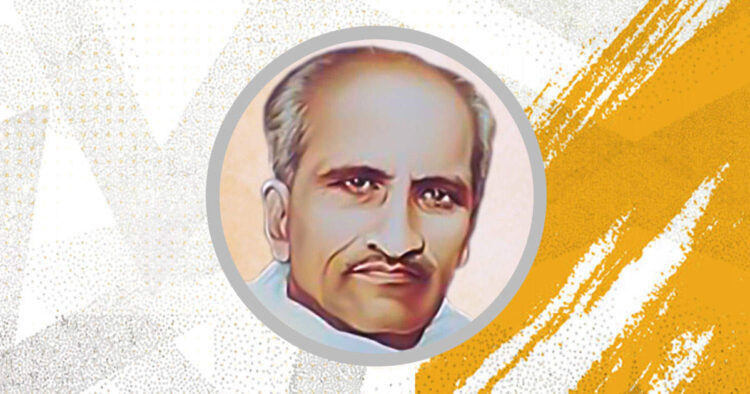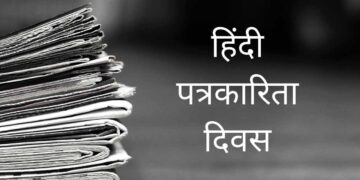Uttar Pradesh News Desk!! Vrindavan Lal Verma (English: Vrindavan Lal Verma, born: January 9, 1889; death: February 23, 1969) was a historical novelist and essayist. He was born in Mauranipur, Jhansi (Uttar Pradesh). His father’s name was Ayodhya Prasad. Vrindavanlal Verma’s educational guru was late Pandit Vidyadhar Dixit.
life introduction
Vrindavanlal Verma was interested in mythological and historical stories since childhood. His primary education took place at different places. B.A. After completing his studies, he passed the law examination and started practicing law in Jhansi. He has had a penchant for writing since the beginning. When he was in ninth class, he wrote three small plays and sent them to Indian Press, Prayag and received Rs 50 as a prize. He also presented the original book titled ‘Biography of Mahatma Buddha’ and the translation of Shakespeare’s ‘Tempest’.
literary life
In 1909 AD, Vrindavanlal Verma’s play ‘Senapati Udal’ was published, which was confiscated by the government. He continued writing short stories till 1920 AD. He started writing essays from 1921. He willingly studied Scott’s novels and was influenced by them. He got inspiration to write historical novels from Scott. He also studied other domestic and foreign novels and literature extensively.
Vrindavanlal Verma ji wrote ‘Garh Kundar’ in two months in 1927 AD. In the same year he also wrote ‘Lagan’, ‘Sangam’, ‘Pratyaagat’, Kundali Chakra’, ‘Prem Ki Bhent’ and ‘Hridaya Ki Hilor’. After writing ‘Virat Ki Padmini’ in 1930, his writing remained postponed for many years. He gradually wrote the satire in 1939 AD and the novels ‘Kabhi Na Kabhi’ and ‘Musahib Ji’ in 1942-44 AD. In 1946, his famous novel ‘Jhansi Ki Rani Laxmibai’ was published. Since then his pen continued to flow uninterrupted. After ‘Jhansi Ki Rani’, he wrote novels like ‘Kachnar’, ‘Mriganayani’, ‘Toote Kaante’, ‘Ahilyabai’, ‘Bhuvan Vikram’, ‘Achal Mera Koi’ etc. and novels like ‘Hansmayur’, ‘Purva Ki Or’, ‘Lalit He wrote plays like ‘Vikram’, ‘Rakhi Ki Laaj’ etc. Story collections like ‘Dabe Paon’, ‘Sharanagat’, ‘Kalkar Dand’ etc. have also been published in the meanwhile.
awards and titles
Vrindavanlal Verma ji has been awarded the literary awards of the Government of India, State Government, Uttar Pradesh, Madhya Pradesh and the best awards of Dalmia Sahityakar Sansad, Hindustani Academy, Prayag (Uttar Pradesh) and Nagari Pracharini Sabha, Kashi. Vrindavanlal Verma ji was awarded D.Litt by Agra University for his literary services. Was honored with the degree of. Many of his works have been awarded by central and provincial states.
creations
mriganayani
Vrindavanlal Verma ji has special interest in history, art, archaeology, psychology, literature, painting and sculpture. His main works are as follows-
main novel
Kachnar
The novel ‘Kachnar’ is based on history and tradition. The background of this novel is historical, the events are also true. But there is no insistence on historicity in time and space. It depicts the continuously struggling and restrained life of an ordinary woman, Kachnar. Besides, a picture of the miserable condition of drug addicts has also been presented. The center of the story is Dhamoni, which was once the princely state of Rajgonds. Along with the story of Kachnar, the author also aims to tell the story of Rajgonds.
mriganayani
‘Mriganayani’ is considered to be the best creation of the writer. It tells the story of Mansingh Tomar of Gwalior state at the end of the 15th century and his queen Mrignayani.
Other subplots
There are other sub-stories as well, like the story of Lakhi and Atal. In this, the plot, characterization, depiction of place, time and environment, everything has been done with conscious artistry. Besides, the political situation of the 15th century has also been depicted skillfully. In ‘Toote Kaante’, along with the depiction of an ordinary Jat Mohan Lal and his family situation, the rise and fall of the life of the famous dancer Noorbai is also depicted. The political, cultural and social life of the 18th century has been shown in these novels in the context of the lives of Mohanlal and Noorbai.
historical novel
‘Ahilyabai’ is a historical novel related to Maratha life. Which includes the life story of an ideal Hindu woman, Ahilya Bai. In ‘Bhuvan Vikram’, the story of the later Vedic period has been presented in an adequate life form with the combination of imagination and historical investigation. The central land of the story is Ayodhya. King Romak of Ayodhya, Queen Mamta and Prince Bhuvan are its main characters. It has a proper combination of Vedic restraint, discipline, ethics, civilization etc. ‘Madhavji Scindia’ is a historical novel with complex incidents. In which the great life of 18th century Peshwa Patel Madhavji Scindia is depicted. Through this novel, the social and cultural life of 10th century India becomes visible. Details regarding ‘Garh Kundar’, ‘Jhansi ki Rani’, ‘Virat ki Padmini’ are visible at their respective places.
social novel
These are ‘Lagan’, ‘Sangam’, ‘Pratyaagat’, ‘Prem Ki Bhent’, ‘Kundalichakra’, ‘Kabhi Na Kabhi’, ‘Achal Mera Koi’, ‘Sona’, and ‘Amarevel’. ‘Lagaan’ is a love story along with a depiction of the conflict and human conflict between two farmers from a prosperous family in Bundelkhand. ‘Sangam’ and ‘Pratyagata’ are related to the traditional feeling of high and low. In these novels, there is a vivid depiction of the rigidity, conservatism, fanaticism etc. of the then caste system and the anarchy and degradation resulting from it. ‘Prem Ki Bhent’ is a small story of a love triangle. The struggle between farmers and landlords is shown in the background of ‘Kundalichakra’. ‘Kabhi Na Kabhi’ is related to the workers. ‘Achal Mera Koi’ depicts the upper middle class and upper class. The novel ‘Sona’ has been written on the basis of a folk tale. The importance of cooperation and labor donation has been shown in ‘Amarvel’.
historical drama
‘Jhansi Ki Rani’, ‘Hansmayur’, ‘East Side’, ‘Birbal’, ‘Lalit Vikram’, and ‘Jahandarshah’. In ‘Jhansi Ki Rani’ the novel of the same name has been presented in drama form. In ‘Speech of Flowers’, the foolishness of those who obtain gold through chemistry is satirized. The basis of ‘Hansmayur’ is the Jain book named ‘Prabhakar Charita’. ‘Eastward’ is a dramatization of the story of the spread of Indian culture in the eastern islands. ‘Birbal’ depicts the efforts of Akbar’s courtier Birbal, who contributed in making Akbar great. The story of ‘Lalit Vikram’ is adapted from the novel ‘Bhuvan Vikram’. The struggling political life of Jahandarshah has been depicted in ‘Jahandarshah’.
social drama
‘Gradually’ is related to the position of the cabinet of the Congress government in 1937 AD. In ‘Rakhi Ki Laaz’, emphasis has been expressed on the spirit of maintaining the best practice of Rakhi in the Hindu society. ‘Bamboo Trap’ is related to the light attitude of college love. In ‘Pele Haath’ there is a picture of such reformers who are slaves to the old traditions of marriage procession. Cheating has been exposed in ‘Sagun’. In ‘Neelkanth’, emphasis has been laid on coordination of both scientific and spiritual viewpoints. ‘Kevat’ is associated with political party. ‘Mangalsutra’ tells the story of the marriage of an unqualified boy with an educated girl. In ‘Search of Toys’ there is a suggestion to solve many problems through morale. ‘Nistar’ is related to Harijan reforms. In ‘DekhaDekhi’ there is a satire on the tendency to spend beyond limits on social events while watching others.
Stories
7 story collections like ‘Sharanagat’, ‘Artist’s Punishment’ etc. have been published. In which different types of stories written by the author at different times are stored.
thinking
The ideology of Vrindavanlal Verma becomes clearly known from his novels. His vision has always been towards the reconstruction of the nation. In all his writings, he has made the orthodox and dilapidated society, the root cause of India’s decline, a laboratory and has pointed out the social evils. These are strong proponents of the importance of labour. Vermaji considers love as an essential element of human life. Not only this, in his opinion love is a spiritual practice, which lifts the seeker from the common ground and takes him towards heights. Their outlook towards life is almost the same as that expressed by ancient Indian culture. According to them, man has the right only to do his work and not to its fruits.
language style
Vrindavanlal Verma ji’s language is mostly character-appropriate. There is a touch of Bundelkhandi in their language. Which is indicative of the regionality of the novels. Even where the description is emotional, his style is not overly decorative but is mainly seen to be combined with appropriate similes. Mainly the style of Vrindavanlal Verma ji is descriptive, in which both the qualities of interestingness and fluency are present. They remain neutral in character analysis of the characters. The characters themselves introduce their characters through events, circumstances and sayings. This is a major reason for the popularity of his novels.
creativity
Vrindavanlal Verma’s work as a historical novelist holds special importance. Among these, there has not been any such novelist in the previous Hindi literature, who has established history on such a wide range of emotions and has formulated the story element behind it with power and insight. In many of Vermaji’s novels, real historical interest is achieved. With this confirmation, he is the greatest Hindi novelist.
supporting texts
Vrindavanlal – Novels and art Shivkumar Mishra Vrindavanlal Verma – Personality and work Padmasingh Sharma ‘Kamlesh’ Vrindavanlal Verma – Literature and review Siyaramsharan Prasad
death
Vrindavanlal Verma, famous as a historical novelist, died on February 23, 1969.






